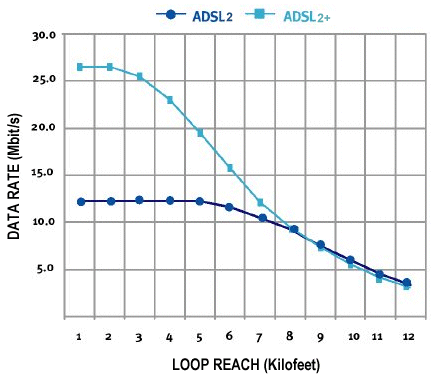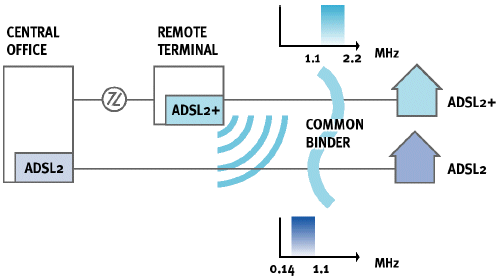ADSL2+ reached consent at the ITU in January 2003, joining the ADSL2 standards family as G.992.5. The ADSL2+ recommendation doubles the downstream bandwidth, thereby increasing the downstream data rate on telephone lines shorter than about 5,000 feet.
While the first two members of the ADSL2 standards family specify a downstream frequency band up to 1.1 MHz and 552 kHz respectively, ADSL2+ specifies a downstream frequency up to 2.2 MHz. The result is a significant increase in downstream data rates on shorter phone lines. ADSL2+ upstream data rate is about 1 Mbit/s, depending on loop conditions.

ADSL2+ can also be used to reduce crosstalk. Since it provides the capability to use only tones between 1.1 MHz and 2.2 MHz, it allows masking of downstream frequencies below 1.1 MHz. This can be particularly useful when ADSL services from both the central office and a remote terminal are present in the same binder as they approach customers’ homes. The crosstalk from the ADSL services from the remote terminal onto the lines from the central office can significantly impair data rates on the line from the latter.

ADSL2+ can correct this problem by using frequencies below 1.1 MHz from the central office to the remote terminal, and frequencies between 1.1 MHz and 2.2 MHz from the remote terminal to the customer premise. This will eliminate most of the crosstalk between the services and preserve data rates on the line from the central office.
- ISDN
- xDSL Digital Subscriber Line technologies – ADSL, HDSL, VDSL
- An Overview of ADSL – What It Is and How It Works
- Glite
- ADSL2
- ADSL2+ | ADSL2Plus | ITU G.992.5
- xDSL Variants
- ADSL Implimentation
- Wires-Only ADSL – Asymmetrical Digital Subscriber Line
- Cable Modems – for cable Internet connections
- A Description and Explanation of Satellite Broadband and How It Works